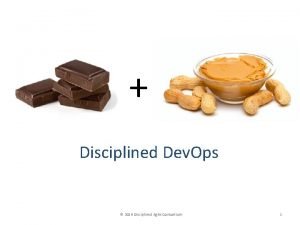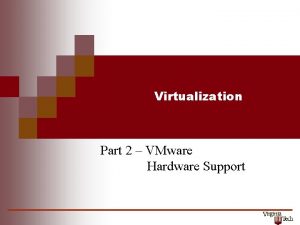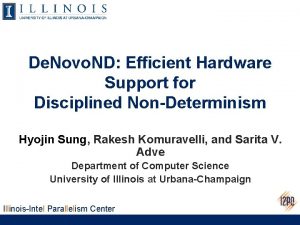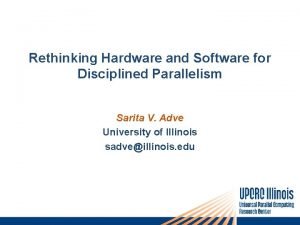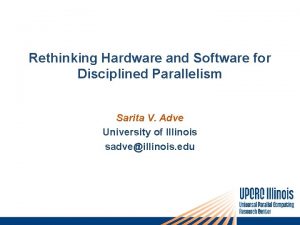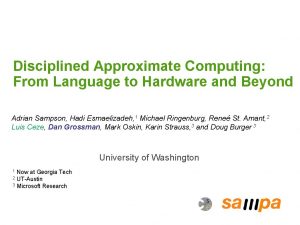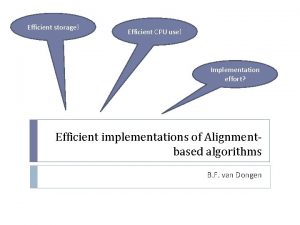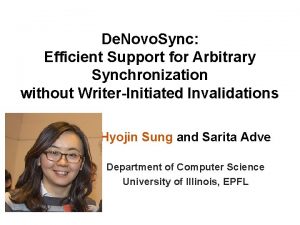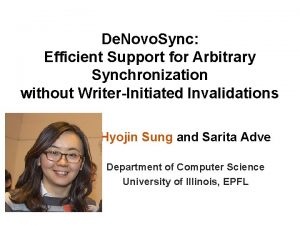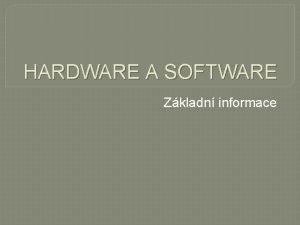De Novo ND Efficient Hardware Support for Disciplined




























- Slides: 28

De. Novo. ND: Efficient Hardware Support for Disciplined Non-Determinism Hyojin Sung, Rakesh Komuravelli, and Sarita V. Adve Department of Computer Science University of Illinois at Urbana-Champaign Illinois-Intel Parallelism Center

Motivation • Shared memory is de-facto model for multicore SW and HW • BUT … – Complex SW: data races, unstructured parallelism, memory model, … – Inefficient HW: complex coherence/consistency, unnecessary traffic, … • Recent work on disciplined shared memory – SW: Easier programming model – HW: Parallelism If SW is more Illinois-Intel Center disciplined, can we build more efficient HW?

Disciplined Shared Memory Disciplined Shared-Memory = Global address space + Implicit, anywhere communication, Explicit, synchronization structured side-effects Illinois-Intel Parallelism Center

Disciplined Shared Memory Deterministic Parallel Java (DPJ) – strong safety properties OOPSLA ‘ 09 • Determinism-by-default, simple semantics explicit effects Disciplined Shared Memory structured parallel control De. Novo – performance, complexity and power efficient PACT ‘ 11 • Simplify coherence and consistency Illinois-Intel Parallelism Center

Limitation • De. Novo for deterministic programs – Important assumptions 1. No conflicting concurrent accesses, only barrier synchronization 2. Known side-effects – Allowed De. Novo to eliminate design complexity and inefficiency • Challenges for nondeterministic programs – The assumptions do not hold any more 1. Can have conflicting concurrent accesses, support lock synchronization Illinois-Intel Center 2. Parallelism Side-effects unknown in critical sections

Contribution Deterministic Parallel Java (DPJ) – strong safety properties • Determinism-by-default, simple semantics POPL ‘ 11 Explicit & safe non • determinism structured Disciplined Shared explicit parallel effects Memory control De. Novo. ND: Non-deterministic codes with benefits of De. Novo • Minimal additional HW for non-determinism • Comparable performance to MESI • 30% lower network traffic than MESI • PLUS all advantages of De. Novo for deterministic codes Illinois-Intel Parallelism Center

Outline • Motivation • Background – DPJ/De. Novo for deterministic codes – DPJ support for disciplined non-determinism • • De. Novo. ND Design De. Novo. ND Implementation Evaluation Conclusion and Future Work Illinois-Intel Parallelism Center

DPJ for Deterministic Codes. . . • Structured parallel control – Fork-join parallelism • Explicit region and effect – Regions divide heap – Read or write effects on regions • Data-race freedom guarantee – Simple, modular type Illinois-Intel Parallelism Center checking LD ST ST . . . write effect heap

DPJ for Deterministic Codes • Java-compatible type system • Structured parallel control • . . . LD ST ST Hardware – simplify coherence – Fork-join parallelism. problems!. Explicit region and effect – Regions divide heap – Read or write effects on regions • Data-race freedom Illinois-Intel Parallelism Center guarantee . write effect heap

• De. Novo for Deterministic Codes Coherence Enforcement 1. Invalidate stale copies in private cache 2. Track up-to-date copy • Explicit effects – Compiler knows all writeable regions in this parallel phase – Cache can self-invalidate before next parallel phase • Registration – Directory keeps track of one up-to-date copy – Writer registers itself before next parallel phase Illinois-Intel Parallelism Center

De. Novo for Deterministic Codes • No space overhead – Keep valid data or registered core id registry – LLC data arrays double as directory • No transient states • No invalidation traffic Invalid • No false sharing Read Write Registered Illinois-Intel Parallelism Center Valid

Example Run X in De. Novo-region Y in De. Novo-region ST L 1 of Core 2 V R X VI Y VI X V R Y . . ST L 1 of Core 1 Registration Shared L 2 Ack self-invalidate( ) Illinois-Intel Parallelism Center Registration V X V Y R C 1 R C 2 Registered Valid Invalid Ack

DPJ Support for Safe Non. Determinism • Nondeterminism comes from conflicting. . concurrent accesses. • Isolate these accesses as “atomic” – Enclosed in “atomic” sections – “Atomic” regions and effects → “Disciplined” non-determinism LD ST . . . - Race freedom, strong isolation - Determinism-by-default • De. Novo. ND converts “atomic” statements into semantics locks Parallelism Center Illinois-Intel

Outline • Motivation • Background • De. Novo. ND Design – Memory Consistency Model – Distributed Queue-based Lock • De. Novo. ND Implementation • Evaluation • Conclusion and Future Work Illinois-Intel Parallelism Center

Memory Consistency Model • Deterministic accesses 1. Same task in this parallel phase 2. Or before this parallel phase. . . De. Novo Coherence Mechanism ST 0 xa Parallel Phase LD 0 xa Illinois-Intel Parallelism Center . .

Memory Consistency Model • Non-deterministic accesses 1. Same task in this parallel phase 2. Or before this parallel phase 3. Or in preceding critical sections. . . ST 0 xa Critical Section ST 0 xa LD 0 xa Illinois-Intel Parallelism Center . . Parallel Phase

Coherence for non-deterministic data • Coherence Enforcement 1. Invalidate stale copies in private cache 2. Track up-to-date copy • When to invalidate? – Between the start of critical section and any read • What to invalidate? – Entire cache? regions with “atomic” effect? – Track atomic writes in a signature, transfer with lock • Registration – Writer updates before next critical section Illinois-Intel Parallelism Center

Distributed Queue-based Lock • Lock primitive that works on De. Novo. ND – No directory, no write invalidation No spinning for lock • Modeled after QOSB Lock – Lock requests form a distributed queue – But much simpler • Details in the paper Illinois-Intel Parallelism Center

Outline • • • Motivation Background De. Novo. ND Design De. Novo. ND Implementation Evaluation Conclusion and Future Work Illinois-Intel Parallelism Center

Access Signatures • Simple and small hardware Bloom filter per core – Track accesses with “atomic” effects only – Only 256 bits suffice • Operations on Bloom filter – On write: insert address – On read: query filter for address for selfinvalidation Illinois-Intel Parallelism Center

Example Run X in De. Novo-region Y in De. Novo-region Z in atomic De. Novo-region W in atomic De. Novo-region ST . . LD ST LD L 1 of Core 1 Z R V R W Read miss Registration ) ) Illinois-Intel Parallelism Center lock transfer X V Y Z VI W Ack self-invalidate( reset filter L 1 of Core 2 Z W V VI Shared L 2 R C 1 R C 2 V R C 1 R C 2 Z V W X R Y Z VR W Read miss Registration Ack

Optimization to reduce selfinvalidation X in De. Novo-region Y in De. Novo-region Z in atomic De. Novo-region W in atomic De. Novo-region . . ST LD LD LD self-invalidate( 1. loads in Registered state 2. “Touched-atomic” bit – Set on first atomic load – Subsequent load don’t selfinvalidate ) Illinois-Intel Parallelism Center • More in the paper

Overheads • Hardware Bloom filter – 256 bits per core • Storage overhead – One additional state, but no storage overhead (2 bits) – “Touched-atomic” bit per word in L 1 • Communication overhead – Bloom filter piggybacked on lock transfer message – Writeback messages for locks Illinois-Intel Parallelism Center • Lock writebacks carry more info

Evaluation Methodology • Simulator: Simics + GEMS + Garnet • System Parameters – 16 in-order cores • Workloads – SPLASH-2, PARSEC and STAMP – Unchanged except region/effect and selfinvalidation • Protocols – MESI and De. Novo. ND – With idealized Illinois-Intel Parallelism Center locks and realistic locks

MESI vs. De. Novo. ND: Idealized lock barnes ocean water fluidanimate streamcluster tsp kmeans ssca 2 • De. Novo. ND performs comparable to MESI for all apps – For both DIL-INF and DIL-256 Illinois-Intel Parallelism Center

MESI vs. De. Novo. ND: Realistic lock barnes ocean water fluidanimate streamcluster tsp kmeans ssca 2 • pthread lock vs. distributed queue-based lock • De. Novo. ND performs comparable or better Illinois-Intel than Parallelism MESI Center

Network Traffic (Realistic lock) barnes ocean water fluidanimate streamcluster tsp kmeans ssca 2 • De. Novo. ND has 33% less traffic than MESI (67% max) – No invalidation traffic – Reduced load misses due to lack of false sharing Illinois-Intel Parallelism Center

Conclusions and Future Work • De. Novo. ND: Efficient HW support for nondeterminism – Minimal additional HW for safe non-determinism – Comparable performance to MESI – 30% lower network traffic than MESI – PLUS all advantages of De. Novo for deterministic codes • Future work: broaden the application space further Illinois-Intel Parallelism Center – Pipeline parallelism, “lock-free” data structures,
 Productively efficient vs allocatively efficient
Productively efficient vs allocatively efficient Productively efficient vs allocatively efficient
Productively efficient vs allocatively efficient Allocative efficiency
Allocative efficiency C b a d
C b a d Allocative efficiency vs productive efficiency
Allocative efficiency vs productive efficiency Disciplined agile consortium
Disciplined agile consortium Disciplined agile delivery roles
Disciplined agile delivery roles Shuhari agile
Shuhari agile What is disciplined
What is disciplined Intellectually disciplined
Intellectually disciplined Superlative younger
Superlative younger Disciplined agile delivery certification
Disciplined agile delivery certification Howard gardner five minds for the future
Howard gardner five minds for the future Internal and external components of a computer
Internal and external components of a computer Cisco ios 種類
Cisco ios 種類 Vmware support hardware virtualization
Vmware support hardware virtualization Device driver does not support hardware shadow maps
Device driver does not support hardware shadow maps What are the signal words
What are the signal words Var 1721 för stormaktssverige
Var 1721 för stormaktssverige Cks
Cks Tack för att ni har lyssnat
Tack för att ni har lyssnat Tobinskatten för och nackdelar
Tobinskatten för och nackdelar Lyckans minut erik lindorm analys
Lyckans minut erik lindorm analys Referat mall
Referat mall A gastrica
A gastrica Tät skog karttecken
Tät skog karttecken Typiska novell drag
Typiska novell drag Multiplikation med uppställning
Multiplikation med uppställning Rbk-mätning
Rbk-mätning





